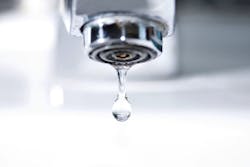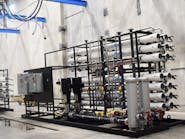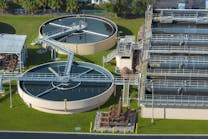Preventing Legionnaires’ disease and other waterborne bacteria through long-term secondary water treatment
Widely publicized outbreaks have occurred in recent years in hotels, hospitals, nursing homes, health clubs and other locations. Since 2001, the Centers for Disease Control and Prevention (CDC) surveillance reports have stated that Legionella is the single most commonly reported pathogen associated with drinking water outbreaks in the U.S. Voluntarily reported cases of Legionellosis tripled to 3,522 annually from 2000 to 2009. The CDC estimates that the incidence is likely a multiple of that figure and that as many as 18,000 people are hospitalized annually with the disease. Clinical research finds that 70 percent of all water systems in buildings with at least three stories are contaminated with Legionella.
Market research indicates serious threats
Research shows that other waterborne pathogens, such as Pseudomonas and Acinetobactor andmycobacterium, are also quite prevalent in drinking water systems. One study, published in 2002 in the Archives of Internal Medicine, found that 43 outbreaks of waterborne Pseudomonas aeruginosa infections occurred in a single year in U.S. healthcare facilities and 1,400 people died as a result.
Legionellosis is a collection of infections that emerged in the second half of the 20th century, caused by Legionella pneumophila and related bacteria. The severity of Legionellosis varies from a mild illness called Pontiac fever to the often-fatal form of pneumonia called Legionnaires ’ disease, which can affect anyone but principally affects those who are susceptible due to age, illness, immunosuppression or other risk factors, including smoking.
Water is the major natural reservoir for Legionella and the bacteria are found worldwide in many different natural and artificial aquatic environments, such as cooling towers, water systems in hotels, homes, ships and factories, respiratory therapy equipment, fountains, misting devices and spa pools. Humans aspirate the bacteria from airborne water particles.
Legionella bacteria are known to infect amoebae and protozoa, which live in the biofilm. Legionella strains that multiply in protozoa have been shown to be more virulent, possibly due to increased bacterial numbers. The ability to proliferate within these hosts provides Legionella with protection from environmental conditions, such as hot water and allows it to resist water treatment with chlorine, biocides and other disinfectants.
Change is in the air … and water
Action is being fueled by regulations in the healthcare industry, with hospitals facing federal and state payment penalties for high rates of infection. It is also driven by the high costs of litigation and business disruption following an outbreak.
A Legionella outbreak in a nursing home in Toronto, Ontario, reportedly killed 23 residents and caused 112 others to be ill. It resulted in a $600 million class action lawsuit. Hotels and health clubs have paid multimillion-dollar settlements. Under the right circumstances — detectable contamination of the water source, the right species of Legionella, a susceptible individual and sufficient intensity of exposure — victims of Legionnaires’ disease can establish the basis for a valid claim, according to Russell Nassof, an expert in Legionella litigation and founder of RiskNomics, a risk management assessment firm.
Facilities are often shut down or operations severely disrupted by an outbreak. Widespread media attention can pose an immediate threat to an organization’s reputation. The American Society of Heating, Refrigerating and Air-Conditioning Engineers will soon promulgate ASHRAE Standard 188: Legionellosis: Risk Management for Building Water Systems, recommending that facility managers implement stronger safeguards through risk assessment and risk management practices. ASHRAE standards are the basis for many municipal building codes. Proactive compliance with the standard will help protect the hospital against negligence claims in Legionella-related lawsuits, but failure to take action will open the door to litigation.
The standard, which is still in the draft revision stage, suggests uniform practices for risk assessment and management. It covers potable water systems, cooling towers, evaporative condensers, whirlpool spas, decorative fountains and other water features, aerosol-generating air coolers, humidifiers and washers.
In addition to most healthcare facilities, it may apply to buildings with:
- Multiple housing units with one or more centralized water heaters
- More than 10 stories, including levels below grade
- Cooling towers or evaporative condensers
- One or more whirlpools or spas within or adjacent to the building
- Devices that release aerosols (e.g., ornamental fountains, misters, air washers or humidifiers)
- Incoming potable water containing less than 0.5 ppm residual halogen, such as chlorine
- Occupants primarily older than 65 years old.
The plan does not mandate a specific water-testing regimen and the CDC doesn’t yet recommend routine environmental cultures. In contrast, a number of county health departments, the World Health Organization and many public health agencies in Europe and Asia do recommend regular environmental surveillance for Legionella.
Widely differing remediation technologies
When Legionella are found through water testing, action must be taken. The standard does not emphasize one modality over another. In the immediate wake of an outbreak, most facilities try these immediate remedies:
- Superheat and flush is often an effective short-term fix in cases of an outbreak. Vendors experienced with this method should oversee the process, as it invariably fails if healthcare facilities personnel supervise the method. The temperature at the tap and duration of the flush need to be documented by infection control practitioners.
- Hyperchlorination entails the introduction of chlorinated salts to the water using a mechanical chlorinator. This raises chlorine levels throughout the system for one to two hours, long enough to kill bacteria. This method is efficacious in initial or emergency disinfection. Chlorine concentrations have to be monitored compulsively; if chlorine concentrations drop below disinfection levels, Legionella quickly re-enters the water distribution system, studies show. Thus, regular use of this chemical must occur, leading to human health risks and damage to water pipes, which corrode with long-term hyperchlorination.
For long-term remediation, a number of modalities have been employed, including:
- In a copper silver ionization system, a flow-cell chamber containing sacrificial copper and silver electrodes is attached to the water supply. A direct current is applied across these electrodes to stimulate the controlled release of ions. The ions form electrostatic bonds with negatively charged sites on microorganism cell walls. These bonds create stresses that lead to distorted cell wall permeability, reducing the normal intake of life-sustaining nutrients. This action, coupled with protein denaturation, leads to cell disintegration and death. Copper silver ionization is the only water disinfection method for which multiple field evaluations of efficacy have been published in peer-reviewed literature. A major 2011 review of all of the existing modalities for remediation of Legionella found that "copper silver ionization appears to be the best available technology today for controlling Legionella colonization in hospital water systems."
- Chlorine dioxide is an easy to generate synthetic gas proven in studies from Europe and a leading American university research hospital to take more than a year to become efficacious in killing Legionella. It breaks down into chlorite and chlorate, both of which have water limits. Chlorine dioxide must be made on-site and the costs associated with training, sampling and laboratory testing for chlorite and chlorate are high.
- Monochloramine, a compound produced by adding chlorine to a solution containing ammonia, is considered effective against Legionella in the biofilm of model plumbing systems. Two case-control studies have suggested that hospitals in municipalities that were supplied with domestic drinking water treated with monochloramine were less likely to report cases of hospital-acquired Legionnaires’ disease. The efficacy of on-site monochloramine treatment in individual hospitals has not yet been studied over a prolonged period. A 2002 CDC study using a model plumbing system with biofilm containing Legionella and other pathogens, compared free chlorine and monochloramine as disinfectants. It found that monochloramine was significantly more effective than chlorine against Legionella in a mixed culture bacterial biofilm.
A need for maintenance
For copper silver ionization, in use at more than 1,400 facilities around the world, a solid-state, microprocessor-based controller automatically maintains the rate at which ions are released. The accurate dose-rate control system maintains precise ion levels, providing residual protection and prevention of recontamination. Like all water remediation, it is not "plug and play." A remote monitoring system allows engineers to track and control operation from anywhere and routine maintenance must be performed, including regular cleaning of the cells.
Copper silver ionization has been registered by the EPA as a pesticide having satisfied efficacy requirements to be able to make claims about the killing Legionella. Ionization has also been selected by the Department of Defense as a requirement for all new healthcare projects in its Unified Facilities Criteria, after a thorough evaluation of drinking water disinfection alternatives by the U.S. Army Corps of Engineers, the Naval Facilities Engineering Command and the Office of the Air Force Civil Engineer. Whatever remediation technology is employed, the emergence of the new ASHRAE standard, increasing litigation costs and damage to organizational reputations should encourage building owners and managers to take action against the scourge of waterborne bacteria and its threat to human health.
Tory Schira is the chief operating officer of LiquiTech Environmental Solutions Inc., a leading provider of environmentally sustainable solutions for dependably clean, safe water systems. He can be reached at [email protected].


